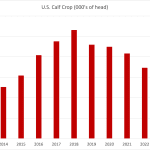Analysts wonder if the special crops industry might run out of gas in the wake of the biofuel boom.
The rapid emergence of the ethanol and biodiesel industries has created new demand for corn, wheat and canola on a magnitude unimaginable two years ago.
“The underlying structure of North American agricultural commodities has fundamentally changed,” said Brian Clancey, editor of Stat Publishing markets newsletter.
“Special crops aren’t going to keep pace and there is a risk that special crops acreage will go down.”
Read Also

Canola used in only quarter of Canadian biofuel
Less than one-quarter of the biodiesel and renewable diesel used in Canada in 2024 was made from canola oil feedstock
Clancey said it is not out of the question that growers will seed an additional one million acres of canola in 2007.
Strong international demand coupled with new oil crushing and biodiesel plants being constructed in Saskatchewan, Alberta and North Dakota have growers excited about the prospects of the crop.
And if wheat and barley markets remain firm into spring, there will likely be additional acreage of those crops.
That acreage has to come from somewhere and while special crops once financially outperformed cereals and gave canola a run for its money in generating gross revenue, they have recently become the poorer cousins of the grains sector.
“Land is being diverted back into traditional crops,” said Clancey.
Garth Patterson, executive director of Saskatchewan Pulse Growers, agrees that the biofuel boom poses a threat to the special crops industry, which has exploded to 6.6 million acres from 2.5 million acres in the early 1990s.
“It’s a great opportunity for the wheat and oilseed industry, but we realize that if there isn’t upward price movement in pulses, we could see a real acreage reduction.”
He thinks peas are at more risk than lentils, which already went through considerable downsizing last spring. Peas are grown in a lot of the same areas that canola is, so there may be some substitution if Clancey’s canola acreage estimate comes to pass.
But he said there are always the non-monetary benefits to factor in, such as the nitrogen-fixing ability of peas, which fits the whole renewable fuels theme. That could keep peas in future crop rotations.
Even if there is a precipitous decline in pulse acreage, that isn’t necessarily all bad news for the industry.
“It actually could have a positive impact on growers by moving prices up,” said Patterson, who noted that Canada is one of the world’s largest exporters of pulses.
Clancey thinks prices will rise this winter as special crops traders attempt to buy acreage by making the crops more competitive with canola and wheat.
“I think the markets have a possibility of reacting in time to save themselves from a collapse. I’m looking for that to play out,” he said.
Based on that assumption, Clancey is projecting a one percent increase in special crops plantings to 6.74 million acres in 2007.
He forecasts that a 226,000 acre decline in pea plantings will be made up for by an increase in lentil and chickpea seeding, and that additional canola and wheat acres will come from summerfallow instead of pulses.
“I probably went real conservative on the (biofuel) effect,” Clancey
acknowledged.
He would have cut pea acreage further had it not been for a weather disaster on the other side of the world.
“If Australia had a good crop I think we’d be looking at a complete disaster in peas. Their drought has saved this industry,” he said.
Patterson cautioned that seeding is still five months away and a lot can happen between now and then. Much depends on the crop in India, the world’s largest producer and consumer of pulses.
It might be a little early to speculate on how the biofuel industry will pan out, considering it is so heavily dependent on government policy that has yet to be announced.
“It’s one of these major paradigm shifts that probably only come along a few times in anyone’s lifetime. I don’t think we know the kind of impact it is going to have,” he said.
All the same, Canada’s pulse industry is going to do everything it can to see how a crop like peas might fit into the ethanol sector so pulses don’t lose the ground they have gained over the last couple of decades.

















